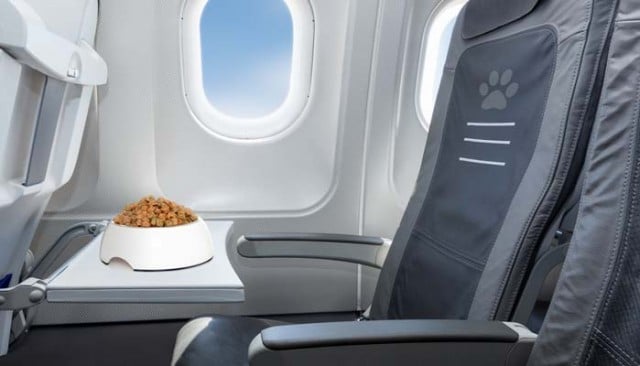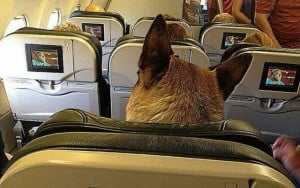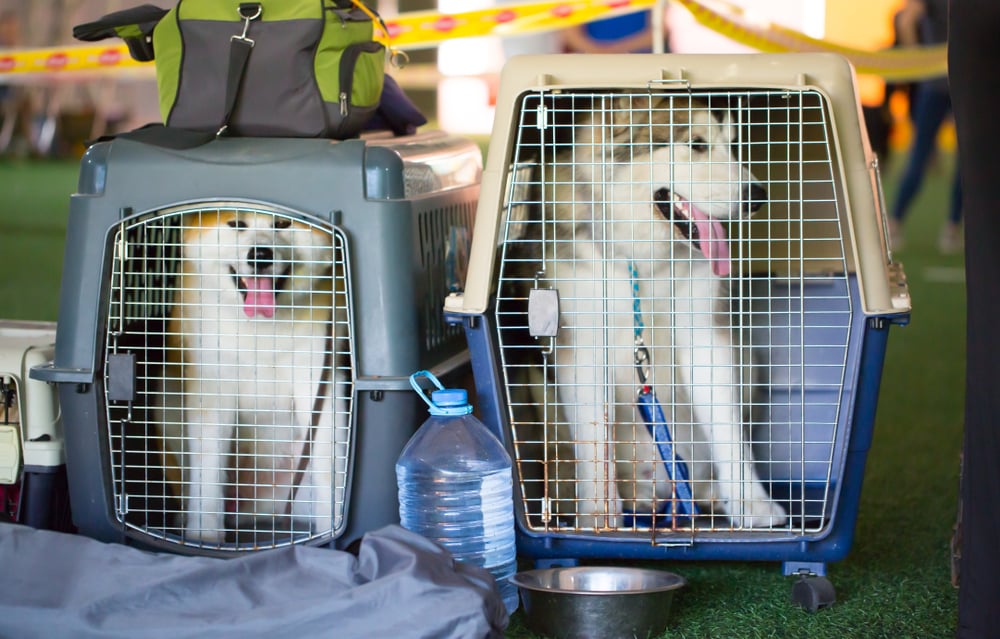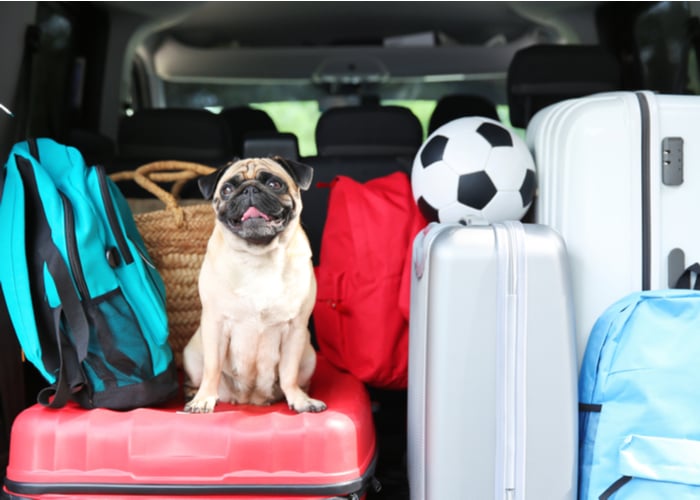
Table of Contents
Did you know that over 2 million pets fly on U.S. airlines yearly?
While flying with your dog may have been a smooth, affordable experience a decade ago, post-pandemic travel and new regulations have made it more complex and costly.
As more people (a.k.a. millennials) own dogs and treat them like their own children, the pet travel industry is arguably livelier than ever.
And as the simplest rule in economics goes: when the demand goes up, the price goes up!
Even domestic travel costs have increased as airlines add fees and limit availability due to heightened demand and reduced pet capacity.
How the Cost of Dog Air Travel Has Changed
In 2015, flying your dog could cost as little as $75–$125 one-way for in-cabin fare, and around $200–$250 for cargo fare.
Today, the price has gotten a little steeper, and the regulations have gotten a little tighter.
In-cabin pet fees rose 20–50% across most carriers between 2020 and 2025.
For example, from $95, Delta's carry-on pet now costs about $150 for local trips with tickets issued on/after April 2025, more than a 50% increase in price!
Check out the table below for the current (2025) one-way ticket prices for different major American airlines:
| Airline | In-Cabin Fee | Cargo Status | Service Animals | Read their Policies |
|---|---|---|---|---|
| Delta | $150 domestic; $200 international |
Only for active U.S. Military or U.S. State Department Foreign Service Officers until further notice | Free with DOT forms | Delta |
| United | $150 each way | (via PetSafe program) Only for active U.S. Military or U.S. State Department Foreign Service Officers until further notice | Free, even for service dogs-in-training | United Airlines |
| American | $150 per kennel | Allowed via American PetEmbark | Free for service dogs | American Airlines |
| Southwest | $125 (US mainland) $35 (between the Hawaiian islands) |
No cargo | Free only for fully trained service animals | Southwest Airlines |
| Alaska | $100 in cabin, $150 in climate-controlled baggage compartment | Available via PetConnect service | Free for service dogs | Alaska Airlines |
| JetBlue | Only accepts small dogs; $125 each way | No cargo | Free for service dogs | JetBlue Airlines |
Some airlines, like United and JetBlue, also allow each person to bring up to two pets, but only when you buy a second seat.
Booking these tickets in advance is important because most aircraft limit the number of animals allowed onboard (JetBlue only allows six animals), and it is on a first-come, first-served basis.
It's important to read each airline's fine print thoroughly to ensure you have everything covered before flying with your pet, from the crate size requirements, documents needed, and the specific policies of your destination.
In addition to the tickets, travel crates, vet certificates, USDA compliance, and rabies vaccine paperwork are additional expenses.
RELATED: Woman Shares Travel Hack for Cheaper Flight With Your Dog
Pandemic & Rabies Rules: A Costly Shift
U.S. Entry and Re-Entry Rules
Speaking of the rabies vaccine, the entry or re-entry requirements for dogs from another country have also been updated recently.
Now, it's more focused on where the dog comes from before returning to the United States.
Apart from the usual requirements like:
- Dogs must appear healthy upon arrival.
- Dogs must be at least 6 months old at the time of entry or return to the U.S.
- Dogs must have a microchip that can be detected with a universal scanner to identify them.
Starting August 2024, you must also complete the CDC Dog Import Form if the dog has only been in a rabies-free or low-risk country for the past six months.
See if the country you have been to is NOT part of this high-risk countries list.
For those coming from high-risk countries, there will be stricter evaluation.
Apart from the CDC Import Form and other requirements above, you will also need:
- a Certification of a U.S.-issued Rabies Vaccination form or a USDA-endorsed export health certificate filled out by a USDA-accredited veterinarian.
- The microchip must also be implanted before the rabies vaccine; otherwise, it will be deemed invalid. The microchip number should also be included on all forms and documents.
If, in case, your dog's rabies vaccines were administered in another country and not in the USA, you will also need:
- Your veterinarian must fill out a Certification of Foreign Rabies Vaccination and Microchip form, which an official government veterinarian must endorse.
- Valid rabies serology titer report from a CDC-approved laboratory,
- Reservations at a CDC-registered animal care facility. If you do not have a valid rabies serology titer, this must include a 28-day quarantine reservation.
- All documents must be in English or translated into English. The translation must be signed and certified by a licensed translator, stamped, and sealed, along with the translator's contact information and license number.
Dogs that haven't been vaccinated WILL NOT be allowed to enter the United States.
These requirements require increased vet visits for clearance and airport screenings, which, frankly, add time, stress, and cost to travel planning with a pet.
Pandemic-brought Changes

It's safe to assume that some, if not most, of these changes in policies and pricing started when the 2020 COVID-19 pandemic affected many businesses worldwide, with the travel industry being among the most hit.
Many airlines had to alter their travel policies; some even had to suspend services like pet transport or cargo programs.
Airlines also introduced more stringent breed and size restrictions, especially for brachycephalic (flat-faced) dogs.
Only select U.S. airports were authorized for incoming international pet travel, reducing flexibility and increasing ground transportation costs upon arrival.
The result has been fewer travel options, longer planning timelines, and higher costs.
Today, some international pet relocations require up to $3,000–$10,000+, depending on the route and services used.
If there's a silver lining that the pandemic has brought to the air travel industry, it's arguably the contactless technology, digital health passports, and possibly cleaner airplanes!
However, years after the pandemic, there's no doubt that it caused a major shift in the industry, especially in terms of costs.
Service Dogs vs. ESA

Another significant change in the pet travel industry is the Department of Transportation's recent overhaul of its air travel policy regarding service dogs and emotional support animals (ESAs).
Before 2020, ESAs were considered service dogs and allowed to fly with their owners free of charge. Now, that's not the case.
Pet owners must now declare their ESAs as pets and pay the standard pet fees.
Only task-trained dogs qualify as service animals. Other species, like cats, miniature horses, birds, and reptiles, are no longer recognized.
Because of this shift, some airlines require passengers to submit standardized DOT forms attesting that their service dog:
- Is a dog trained to perform disability-related tasks
- Behaves properly in public
- Is healthy and in control
A Service Animal Relief Attestation Form is also required for flights over 8 hours, confirming the dog can relieve itself and remain sanitary during the flight.
This policy shift aims to reduce fraud, improve passenger safety, and clarify travel rules for service animals, making travel smoother for passengers with legitimate service dogs and aligning air travel norms with the Americans with Disabilities Act.
RELATED: No More Emotional Support Animals on Planes
Better Alternatives to Flying with Your Pet
If the price becomes too high, there are better alternatives to going on a vacation with your dog.
You can go road-tripping!
Sure, the trips may be longer, but at least you're in a controlled environment, as long as you have the appropriate car accessories for your and your dog's comfort and safety.
If you're relocating long-term, you can also try pet ground transport services. They're safer and cost-effective, although the travel time is also slow.
If it's a leisure trip for only a few days, you might consider leaving your dog behind. You can check out dog boarding services or hire a pet-sitter who can also look after your house.
This is the best option you have to ensure your pet's comfort!
RELATED: Pet Sitter or Boarding (Choose What's Best For You)
Is Flying with Pets Still Worth It in 2025?
At the end of the day, this still depends on how much money and effort you're willing to spend to bring your dog along with you on the trip.
It might be worth it when the travel makes sense!
Examples are if you're relocating long-distance or internationally, your dog is small enough for in-cabin travel, or if you own a legit service dog with complete documentation.
However, you'll have to go through the chaos of paperwork, and for some, that can be a dealbreaker.
Air travel with dogs is still possible, but much more expensive, regulated, and cumbersome than before. And nowadays, it’s no longer a casual decision but a planned operation.














